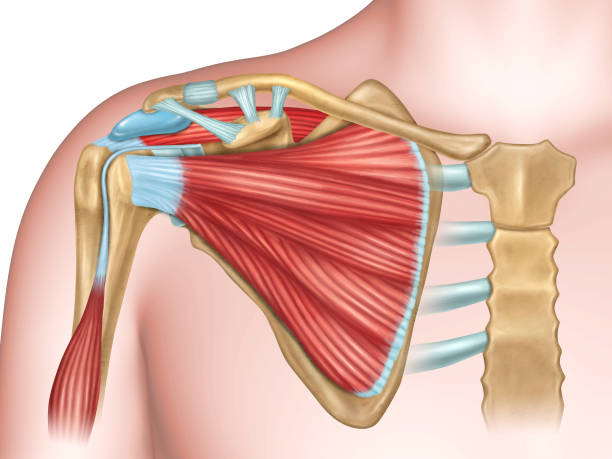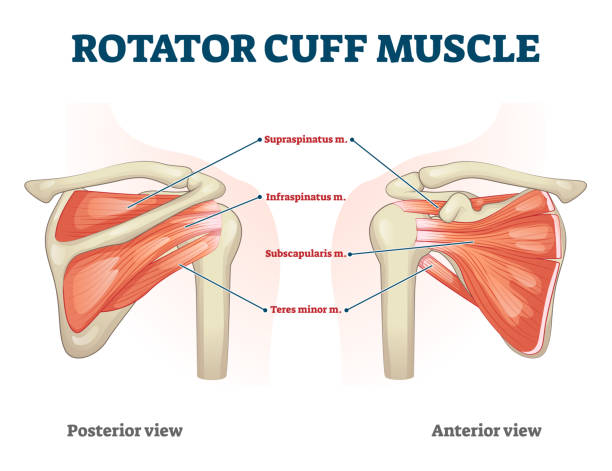Supraspinatus Stretch: Your Supraspinatus Muscle & Rotator Cuff
Effective Stretches for Your Supraspinatus Muscle
The supraspinatus is one of the four rotator cuff muscles that play an important role in stabilizing and moving your shoulder joint. This small but mighty muscle helps lift your arm out to the side and overhead. It also keeps the head of your upper arm bone firmly in the shoulder socket as you raise your arm.
Unfortunately, the supraspinatus tendon is prone to overuse injuries and tearing. Shoulder impingement syndrome, rotator cuff tendinitis, rotator cuff tears, and frozen shoulder can all cause pain and limit shoulder range of motion.
That's where supraspinatus stretches come in! Stretching this often overlooked rotator cuff muscle can help improve flexibility, range of motion, and strength. It may also aid recovery from various shoulder injuries.
This guide will explore the top stretches to target your supraspinatus. Learn proper form, modifications, and how to incorporate these stretches into your routine. Let's dive in!

Why Should I Stretch My Supraspinatus Muscle?
There are several key benefits to stretching the supraspinatus muscle:
- Relieves Tension and Pain - Stretching helps relieve muscle knots and tension that contribute to shoulder impingement and pain. Gentle stretching can ease soreness from overuse.
- Increases Flexibility - Supraspinatus stretches lengthen the muscle and improve mobility of the shoulder joint through the full range of overhead arm motions.
- Prevents Injury - Stretching keeps muscles supple so they can better withstand the demands of various overhead arm activities and resist tearing.
- Aids Rehab and Recovery - Early stretching helps restore range of motion and function after rotator cuff tears or surgery. It also facilitates healing.
- Enhances Performance - With improved flexibility and shoulder mechanics, you can perform activities like serving in tennis or spiking a volleyball more efficiently.
Now that you know the many benefits, let's explore some of the top stretches for targeting your supraspinatus muscle.
1. Crossover Arm Stretch
This excellent stretch targets the supraspinatus muscle as it passes laterally over the shoulder joint. Here's how to do it:
- Stand or sit tall with good posture. Relax your shoulders and gently pull one arm across your chest as far as possible, holding at your upper arm.
- Hold for 30 seconds and relax. Repeat on the opposite side.
- For a deeper stretch, grasp the elbow of the stretched arm and gently pull it farther across your chest.
- Repeat 2-3 times on each arm.
This passive stretch isolates the supraspinatus muscle and can relieve impingement discomfort. Go slow and stop if you feel any pinching.
2. Internal Rotation Stretch with Elastic Band
The supraspinatus muscle externally rotates the arm, while the infraspinatus and teres minor internally rotate it. This stretch leverages internal rotation to target the supraspinatus.
- Loop a stretch band around a stable object at waist height. Hold one end in your hand with elbow bent 90 degrees.
- Keeping your elbow pinned to your side, slowly rotate your arm across your body as far as possible until you feel a mild stretch in the back of your shoulder.
- Hold for 30 seconds, then return to start position. Repeat 2-3 times then switch arms.
The elastic band provides added resistance to maximize the benefits of this supraspinatus rotation stretch.
3. Passive Internal Rotation Stretch
This supraspinatus stretch takes basic internal rotation even farther:
- Lie on your side with the injured shoulder up. Bend your elbow 90 degrees.
- Have a partner or therapist gently grasp your wrist and lower arm, then slowly internally rotate your arm as tolerated across your body.
- Only go to the point of mild stretch - no pain. Hold for 30 seconds and repeat 2-3 times.
- For self-stretching, use a pillow or foam roll behind you to prevent over-rotation. Gently guide your arm across your body until you feel the stretch.
This passive method allows gravity to provide a deeper stretch great for loosening tight or injured shoulders. Go slow!
4. Sleeper Stretch
The sleeper stretch opens up the posterior shoulder capsule and targets the supraspinatus and infraspinatus rotator cuff muscles. Follow these instructions:
- Lie on your side with the injured shoulder down. Bend your elbow to 90 degrees.
- Keeping your elbow fixed in place near your ribcage, use your opposite arm to gently push your other hand toward the surface behind you.
- Stop when you feel a mild stretch in the back of your shoulder.
- Hold 30 seconds, then relax arm across your body again. Repeat 2-3 times.
The key is keeping your elbow stabilized as you stretch those rotator cuff muscles in the back of the shoulder socket.
5. Assisted Internal Rotation Stretch
For this stretch, you'll need a stick or cane:
- Hold a stick behind your back with it lined up horizontally across your shoulder blades.
- Grip both ends of the stick with a shoulder-width overhand grip.
- Pull the stick horizontally to the left to stretch your right shoulder. Push to the right to target your left. Only go to the point tension - no pain.
- Hold for 30 seconds then release back to start position. Repeat 2-3 times per side.
This dynamic stretch allows you to control the intensity in each direction. Move slowly until you feel the supraspinatus engage!
6. Standing External Rotation With Band
Now let's stretch the opposing muscle groups. This move strengthens the infraspinatus and teres minor while stretching the internal rotators:
- Secure a resistance band around a stable object. Grip one end of the band and pull your hand a few inches away to create tension.
- With your elbow pinned at your side and fixed at a 90o angle, slowly rotate your arm backward as far as possible until you feel a mild stretch.
- Slowly return to the start position - don't let the band snap back! Repeat 10-15 times.
- Complete 1-2 sets then switch sides.
This dynamic stretch combo targets those smaller external rotators to relieve overuse.
7. Forward & Back Arm Swings
Simple pendulum arm swings help stretch the supraspinatus and enhance range of motion:
- Stand with good posture. Lean forward and place one hand on a table for support. Let your other arm hang freely at your side.
- Keeping your back straight, slowly swing your arm forward and back as far as feels comfortable. Relax your shoulders.
- Do 10-15 swings then reverse direction for 10-15 swings to stretch the backs of the shoulders.
- Complete a few sets then switch arm positions and repeat.
This gentle, rhythmic movement provides an excellent way to stretch the supraspinatus and surrounding upper back muscles. Increase range of motion over time.
8. Assisted Horizontal Arm Stretch
Have a partner help isolate your supraspinatus:
- Stand with your arm out straight, palm flat on the surface at shoulder height. Stabilize your shoulder blade.
- Use a dowel. Apply gentle pressure to stretch your arm horizontally along the dowel to the point of mild tension.
- Hold steady for 30 seconds, then relax. Repeat 2-3 times then reverse positions.
The key is keeping your shoulder stabilized as you stretch your arm to target the strains on that supraspinatus tendon.
Incorporating Stretches into Your Routine
Perform the full circuit of stretches 2-3x per week, holding each stretch for 30 seconds and repeating 2-3 times per side. Move slowly until you feel tension, not pain. Relax your shoulder between stretches.
Supraspinatus stretches can be done as part of a warm-up, cool-down, or standalone flexibility training. You can also passively stretch while relaxing on the couch! This helps recovery between strength training sessions.
Stretching the supraspinatus and rotator cuff is an important way to enhance shoulder health. But don't neglect rotator cuff and scapular strengthening exercises to best support your shoulder. Physical therapy including modalities like massage or ultrasound may also help recovery.
Stay within your limits to avoid compensation patterns and further injury. Reduce intensity if a stretch causes pain. Let pain be your guide and check with a physical therapist or sports medicine doctor for personalized treatment.
With routine stretching and strengthening, you can keep your supraspinatus flexible and strong for optimal shoulder function during daily and overhead arm activities. Say goodbye to shoulder impingement and hello to pain-free range of motion!

Frequently Asked Questions
What is the proper form for the pendulum stretch?
Lean forward and place one hand on a table for support. Let your other arm hang freely at your side. Keeping your back straight, slowly swing your arm forward and back as far as feels comfortable. Relax your shoulders. Do 10-15 swings then reverse direction for 10-15 swings to stretch the backs of the shoulders.
How do I know if I am feeling a stretch in my supraspinatus during abduction exercises?
As you raise your arm out to the side, away from your body in abduction, focus on keeping your shoulder blade stabilized and not winging out. You should feel a mild stretch in the upper back and side of your shoulder at the endpoint range of motion. Do not push into pain or pinch.
Why might I experience shoulder pain when stretching my supraspinatus?
If a supraspinatus stretch causes pinching, sharp pain, or aggravates existing shoulder impingement symptoms, the stretch is too intense. Ease up to avoid compensation patterns and further injury. Let pain be your guide and reduce the range of motion or intensity. Consult a physical therapist if pain persists despite modifications.
How can I get a deeper stretch of my supraspinatus during shoulder blade retraction?
To get more benefit from a standing row or shoulder blade pinch, be sure to retract your shoulder blades fully together while keeping shoulders relaxed down away from your ears. You can hold light hand weights for extra resistance. Drive your elbows back keeping them pointed down to better engage the supraspinatus.
What is proper form for the internal rotation stretch using a resistance band?
Stand holding one end of the band with your elbow fixed at a 90-degree angle by your side. Slowly rotate your arm across your body as far as possible until you feel a mild stretch in the back of your shoulder. Only go to your point of tension. Hold for 30 seconds before slowly returning to the start position.
Why is it important to keep my elbow at a 90 degree angle during elastic band stretches?
Bending your elbow at a 90 degree angle helps isolate the rotational motion to protect your elbow and engage the intended muscles - the supraspinatus and infraspinatus. This prevents compensation from other muscles, focusing the stretch where needed. Keep your motions slow and controlled.
How much weight should I use for supraspinatus strengthening exercises?
Start with no weight, focusing on form. Then add weight in 1-pound increments, building to a maximum of 3 to 5 pounds. You only need light weights to effectively strengthen your rotator cuff muscles without straining them. Progress slowly over several weeks.
Should the exercise band loop around my wrist or hand during stretches?
For optimal comfort and security, loop the center of the elastic stretch band around the mid-palm of your hand instead of the wrist. This helps prevent the band from painfully digging into wrist bones during rotational movements. Adjust fit as needed.
What should my other arm be doing when performing supraspinatus stretches?
Anchor your non-stretching arm by placing that hand on your hip or behind your lower back during unilateral stretches. This stabilizes your body, allows you to isolate one shoulder joint, and prevents unwanted movement for better stretch efficiency.
If I feel burning or fatigue during repetitive stretches, should I push harder or stop?
Take it as sign to stop and take a break! Muscle burning or fatigue that sets in quickly means the supraspinatus is getting overworked. Continuing despite these warning signs risks compensation or injury. Rest 30-60 seconds between sets and modify intensity as needed.
What direction should I move my arm during dynamic stretches using a stick?
Stand holding a stick horizontally behind your back. To stretch your right shoulder, push the stick to the right while resisting with your left arm. Only go until you feel mild tension - no pain or pinching. Hold for 30 seconds then gently bring stick back to center before repeating the opposing direction.
Why is scapular stabilization so important when doing the standing row?
Proper form is key to avoid shoulder impingement when rowing your arms backward. Keeping your shoulder blades retracted down and back allows greater range of motion to stretch your supraspinatus and lats. But don't hunch or allow shoulders to creep up. Maintaining neutral alignment reduces injury risk.
Will supraspinatus stretches help me regain external rotation range of motion?
Yes, stretches that target the teres minor and infraspinatus in the back of the shoulder can help restore external rotation mobility lost due to injury, strain, or tightness. Go slowly and gently during both active-assisted and passive stretches to improve flexibility without further irritation. Patience brings progress!
Which side should I lie on to stretch my left vs right supraspinatus?
To target your left supraspinatus, lie on your right side. Bend your left elbow at 90 degrees and use your right hand to gently stretch the left arm across your body. To stretch the right supraspinatus, simply flip sides, lying on the left and stretching your right arm across.
Why do I need to stabilize my shoulder blade when doing the sleeper stretch?
Fixing your shoulder blade in place better isolates the stretch to the shoulder joint capsule and supraspinatus tendon instead of the trapezius. Allowing the shoulder blade to wing up off the surface can tweak the trapezius and limit range of motion. Proper form protects!
Hopefully these tips help explain proper stretching techniques and answer common questions about the supraspinatus muscle. Always listen to your body and consult a physical therapist if pain or tightness persists. Stay safe!

Ask the PT: Pro Tips for Mastering Your Supraspinatus Stretch
(Interview)
Hey there! I'm Sarah, a licensed physical therapist with a passion for empowering people to move freely and confidently. Today, we're diving into the world of the supraspinatus stretch – a game-changer for anyone battling shoulder tightness. But let's face it, stretching guides can leave you feeling more confused than a penguin in a snowstorm. That's where I come in! Think of me as your personal PT translator, here to break down the best practices and answer all your burning questions.
Let's start with the basics: How do I know if my supraspinatus needs some TLC?
Listen to your body! Common culprits include achy mornings, struggles reaching overhead, or that nagging feeling like your shoulder is holding back on the fun. If these sound familiar, a good supraspinatus stretch could be your new BFF.
Okay, I'm convinced. But there are so many variations online! Which one's right for me?
There's no one-size-fits-all answer, my friend. It depends on your individual needs and fitness level. But don't worry, I've got some gems to get you started:
For the Gentle Souls:
- The Doorway Stretch: Stand in a doorway, forearms on either side. Lean forward, feeling a stretch in your chest and shoulders. Hold for 30 seconds, repeat as needed. This is a great warm-up or cool-down stretch.
- The Pendulum Swing: Stand tall, lean forward, and let one arm hang freely. Gently swing your arm back and forth in small circles, gradually increasing the range of motion. Feel the tension melt away!

Ready to Up the Ante?
- The Crossover Arm Stretch: This classic targets your supraspinatus directly. Bring one arm across your chest, using your other hand to deepen the stretch. Hold for 30 seconds each side. Remember, quality over quantity – a gentle stretch is more effective than forcing it.
- The Internal Rotation Stretch: Want to go deeper? Bend your elbow at a 90-degree angle, palm facing you. With your other hand, guide your forearm across your body. Hold for 30 seconds each side.
Bonus Tip: Add an elastic band for an extra challenge! Loop it around a doorknob and use it for assisted stretches or added resistance. But remember, start light and gradually increase as you feel comfortable.
Hold on, I have a question about this specific move...
Ask away! Whether it's the "squeezing your shoulder blade" part of the sleeper stretch or the "pushing the stick horizontally" in the external rotation stretch, I'm here to break it down and make sure you're performing the exercise safely and effectively.
Remember, form is key! What are some common mistakes to avoid?
- Hunching your shoulders: Keep your shoulder blades together and relaxed throughout the stretch.
- Forcing it: Listen to your body! Pain is a no-go. Ease into the stretch and gradually increase intensity.
- Holding your breath: Breathe deeply and rhythmically throughout the stretch.
- Going too heavy, too fast: Start with light weights or bodyweight and gradually increase as you get stronger.
I always get confused about reps and sets. How many times should I do each stretch?
Aim for 2-3 sets of 8-12 repetitions for each stretch, 2-3 times a week. But remember, this is a guideline, not a strict rule. Adjust based on your individual needs and how your body feels.

Should I stretch every day, even if my shoulder feels fine?
Regular stretching is great for maintaining flexibility and preventing future issues. However, if your shoulder is already sore, focus on gentle stretches or rest until the pain subsides. Remember, stretching shouldn't hurt!
One last thing: What if my shoulder pain persists after stretching?
If you're experiencing persistent pain, it's crucial to consult a healthcare professional like myself. We can assess your individual situation and create a personalized treatment plan to get you back to moving pain-free.
So, there you have it! Expert advice for mastering your supraspinatus stretch. Remember, consistency is key, listen to your body, and don't hesitate to ask for help if you need it. Now go forth and conquer those tight shoulders!
For More Training Advice + Diet and Lifestyle visit us RIPL Fitness
PS: Make sure you check out the rest of our Shoulders Training Guides:
8 Best Compound Shoulder Exercises
Around the World Shoulder Exercises + Workout
5 Frozen Shoulder Exercises For Pain Relief
10 Best trx shoulder exercises | TRX Suspension Training
Shoulder Calisthenics Workout | Bodyweight Shoulder Workout
10 Best Shoulder Dislocation Rehab Exercises
16 Best Cable Shoulder Exercises To Build Muscle & Shape Delts
8 Best Shoulder Bursitis Exercises
Shoulder Impingement Exercises For Shoulder Impingement Syndrome
The 10 Best Cable Shoulder Workouts & Cable Shoulder Exercises

